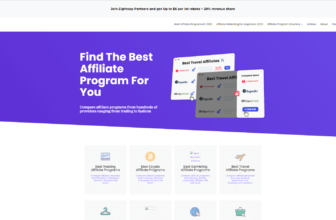
How to be Successful with Affiliate Programs in 2024
You have created your website, signed up for an affiliate program, but all effort to be successful with the affiliate program you signed up for has proved abortive. To avoid hitting a block and giving up on your dreams of making money online, you must understand what is required to be successful in affiliate marketing.
A projection by Statista has shown that by the end of 2022, business spending on affiliate marketing in the United States will hit a whopping $8.2 billion! Now, you can take advantage of that if you start early and position yourself strategically for a perfect take-off!
Once you have found out the elements and characteristics required to be successful in affiliate marketing, it becomes easy to set your standard and work towards it to achieve your affiliate marketing goals.
This move doesn’t matter if you have been in the industry for quite some time or just starting as a total affiliate marketing beginner. In this article, you’ll learn how to be successful with an affiliate program – so long it’s legit!

Why Choose Affiliate Marketing?
Affiliate marketing involves promoting a company’s product or service and receiving percentage commissions on successful sales. While commissions are often given in different percentages, some companies may offer only a fixed amount on sales.
Here are important reasons to get into affiliate marketing.
1. Starting requires low cost and low risk. Generally, starting a business requires setting aside some considerable amount for creating products, acquiring equipment, paying for rent, employing workers, and all of that.
These expenses are relatively high and risky, but it’s not like that with affiliate marketing.
For affiliate marketing, all you need is your website and maybe social media business pages, and you’re set to launch out.
2. You become your boss! You’ve always wanted to be free from waking up at ungodly hours, getting into the streets jammed with commuters while half-asleep, driving through gridlock, joggling around with huge files at work, and then relishing the sweet release at five. Affiliate marketing offers you the opportunity to be free and become your own boss on a platter of gold!
3. Targeted audience. Since the products you’ll be marketing will be products that you have chosen by yourself, you can be sure to pick and blog about products specifically targeted at meeting the needs of your visitors.
4. Easily scalable. A typical salesperson can only sell products that a single company provides. But as an affiliate marketer, you can market for different companies at a time and earn commissions from all of them.
How Does Affiliate Marketing Work?
To become an affiliate marketer, you need to sign up with an affiliate program. Affiliate programs are often linked directly to businesses, and they are targeted at boosting the growth of companies. The business owner provides unique affiliate links to each affiliate to help them track clicks and sales to get commissions on products sold.
A software file called ‘cookie’ is stored on your device to help the affiliate merchant attribute sales to you. So, you earn commissions on purchases made by people you refer to the company through your affiliate link. Companies have different rules as regards using cookies. While some cookie-duration is 24 hours (like Amazon) and will only track potential purchases within that time, others may last up to 30 days (like ClickBank).
How Much Can You Earn As An Affiliate Marketer?
As an affiliate marketer, you cannot determine your earning potential without considering your niche and strategies in the marketing process.
Top affiliate marketers make up to six figures per month from affiliate marketing, and you too can. Affiliate marketers like Pat Flynn (who earns over $100,000 per month), Missy Ward, and Finch Sells are good examples to follow.
Wirecutter, founded by Brian Lam, made an all-time revenue of $10 million from affiliate marketing. They got the attention of The New York Times which went on to acquire the site for a whopping $30 million!
The brand did not get there by just wishing. It required a long period of employing the right strategy, hard work, and consistency. So, if you’re just starting as a beginner, you’re not likely to get the big bucks straight away. Keep working and stay focused; you’ll become the next big thing if you do!

How To Get Started As An Affiliate Marketer
To begin with affiliate marketing and ultimately succeed in the field, there are a few steps you need to consider.
Step One: Choose a platform for your marketing activities
There are several platforms you can use to connect with your audience with your affiliate tactics. You can create a website or leverage it on social media channels like Instagram, Facebook, YouTube, or Pinterest.
Consider blogging as a top option. You do not need so much investment to start blogging, and available are numerous online resources that would teach you how to be successful in blogging. You’ll need to have some good knowledge of SEO to help you optimise your content for a good chance of ranking on search engines.
You can also leverage YouTube for creating and uploading content that includes your affiliate links. You do not have to make any significant investment to get started on the platform. Simply create contents that resonate with your audience and add your affiliate links.
However, ensure to comply with the Federal Trade Commission (FTC) guidelines which require transparency to your audience when you earn from introducing other people’s products to them. You can add this information in the footer section of your blog, on a standalone page, or add it in the description of your YouTube channel.
Step Two: Identify A Profitable Niche
There are an estimated 1.7 billion websites on the internet, and out of that figure, 600 million are blogs. In the United States alone, there was an estimate of 31.7 million blogs in 2020. So, in all your niche-finding, you want to find a niche that is not congested and clogged and will not compound the challenges of ranking on search engines.
You also want a niche that has at least a fair commission rate. Do not try to cover so many niches at a time. It may be tempting to try multiple niches for a potential increase in revenue, but to stand a better chance of being successful with an affiliate program, you have to niche down!
Pick a broad niche category. Let’s say “food,” but instead of focusing on that category, get more specific with your niche with something like “grilling food,” “eating healthy,” “dieting,” and so on. By doing so, you’ll give your content a better chance of ranking high on search engines.
As you continue to gain mastery of this category and build traffic to your pages, you can expand into other areas of the broader niche.
In addition, if you’re going to be the sole content creator on your blog, be sure that your area of focus is your area of interest. Your passion for the topic will help you to keep going when things get tough. You do not want a blog that will become a shadow of itself after several months of running.
And if you will be outsourcing, you had better get experts in the niche to get things done for you. These experts know what it takes to create high-quality, trustworthy, and highly engaging content that will drive traffic and convert them, leading to increased affiliate sales.
Step Three: Join an affiliate program
After deciding on a profitable niche, find an affiliate program to join. The affiliate network must be one with products that resonate with your passion. Affiliate programs are often in three models, and they are given below.
- Affiliate programs with high volume and high commission rates: One of the affiliate programs you’ll find in this model is one with products for mass appeals, such as credit cards. We all need credit cards, and when we get one, we rarely switch from the company.
But one downside of products like this is that they often attract affiliate marketers that may be hard to compete against. However, if your focus is on consumers, you may want to consider the next affiliate model.
- Affiliate programs with high volume but low commission rates: These products have low commission rates and attract high demand because of their vast mass appeal. Amazon only offers between 1% to 10% commission on all their products because they attract a high sales volume. You can earn more on the program when your visitors find other products that interest them on the platform outside the one you recommend, and they go ahead to purchase them.
Having massive traffic is a success-determinant of this category.
- Affiliate programs with low volume but high commission rates: The products enlisted under this category have high-paying potentials but not vast mass appeal. An example is ConverKit’s affiliate program that pays almost $1400 when you refer 160 customers to buy their products. Programs with high commissions also tend to be highly competitive. And since you are a beginner affiliate marketer who wants to be successful with an affiliate program, you may find it hard to compete against skilled and deep-pocketed affiliate marketers.
This model works nicely for bloggers and marketers targeting a business audience. Products in this category are often software and web-hosting related.
Step Four: Create unique and engaging content
You’ll need to create regular authentic, engaging content for your readers if you want to succeed as an affiliate marketer. This is not about publishing a blog post once in six months. If you really can not do the writing yourself, you should consider employing skilled SEO writers to get the job done.
You can do product reviews too, but you should take it a step further as Wirecutter did by buying the affiliate products and testing them for firsthand information on how they work. No doubt, you may not be able to afford all the products at once; however, you can begin with the ones you already have. This is one of the secrets of Wirecutter’s success in affiliate marketing.
Step Five: Drive traffic to your online affiliate page
You may have heard several times that “content is king” and that traffic will flow naturally once you create amazing content. Today, you need a strategy to drive traffic to your content. If you do not drive traffic to your blog and online pages, you’ll have created great content, but no one will notice them. So no revenue from your affiliate efforts.
These three strategies will help you to drive a good amount of traffic to your blog.
1. Search Engine Optimization (SEO)
SEO involves optimizing your pages to gain visibility on search engines such as Google and Bing. It is often better to focus on less competitive niches that are also reasonably profitable. Once you begin to rank on search engines for relevant keywords, you’ll get traffic, producing a percentage of potential buyers on your affiliate products.
Ultimately, SEO is about knowing what your target audience wants and making it available to them.
2. PPC – Pay Per Click
If you have some good cash to invest, then you should consider doing some paid ads. This strategy will generate instant traffic! But a downside is that your traffic stops when your paid ad stops running.
Another issue with this is that you dig into your profits even while you haven’t made a dime when you run ads. But this is normal with advertisers. You only need to understand how long it would take for your paid campaign to optimize.
Paid ads are a great way of getting quick sales if your affiliate model is high-paying and you understand how to get the best of the strategy. But if you’re a beginner affiliate marketer or your affiliate model requires low commission rates, you should work on your SEO or consider building your email list.
3. Build your email list
With your email list, you can often communicate with your readers. Tell your fans about updates on your blog and how they can be of benefit to them. This constant emailing will keep them returning to your site and generate more clicks to your affiliate links.
You may even choose to send direct affiliate email promotions to them!
There is a wide range of plugins that can help you grow your email list. Once you have any of them installed, encourage your readers to sign up with them. A common strategy is to offer something that the readers will appreciate to release their emails gladly.
You can offer free courses, free ebooks, or free membership, among others.

Step Six: Get strategic with your affiliate links.
Having great content on your site doesn’t mean that your readers will automatically click on your affiliate links. You need to consider a few things to boost your success in affiliate marketing.
A. Callouts
Consider callouts such as tables, buttons, or boxes with product links to make the post skimmable for your readers and retain their interest.
B. Link placement
You must be able to position your links to look natural and easy to access for your readers.
If you place your links at the bottom of your page, you will only get a few clicks to them. On the other hand, your readers may become nauseated by your strategy if you spam your content with affiliate links. So, get creative!
C. Context
Use affiliate links in the proper context. Your anchor texts should be relevant to your affiliate linking page so that your readers can have a fair idea of the content before deciding to click on it.
Step Seven: Convert clicks to sales
For you to earn from your affiliate marketing efforts, you must have two successful conversions. The first is the click you generate to your affiliate product page through the tactics already provided here. And the second conversion occurs at the point of purchase. As an affiliate marketer, the second conversion isn’t within your control, so it is essential to check with programs that convert well.
Mistakes to avoid in affiliate marketing
As soon as you’ve mastered the basics of affiliate marketing, be sure not to skip any details. Making a few seemingly insignificant decisions can determine your success or failure. You should avoid the following affiliate marketing mistakes:
Overlong introductions. Whether producing content or videos, you’ve only got a few seconds to grab your audience’s attention. Be concise and clear in your introductions. Let them know what they’ll gain if they stick around.
Mistargeting. It doesn’t matter how hard you market; your audience won’t convert if they don’t understand the offer. Content should be tailored to the needs of your audience, incorporating education when necessary.
Lack of a clear top recommendation. Consumers want to see a clear recommendation, not a product roundup or comparison. Let them know your preference so they can make an informed decision.
Providing no alternative products. Consumers are becoming a skeptic. A product that claims to be a cure-all should raise red flags. You should instead make honest assessments and acknowledge the benefits of other options. You can even earn revenue by linking to competing products.
Not tracking. Affiliate marketers who are successful view their marketing as a business. In some cases, product matrices are not tracked, leading to failure. Rather than relying on gut instinct or guesswork for revenue optimization, consider data-driven insights.
Don’t make these mistakes, and you’ll be far ahead of the 90% of affiliate marketing beginners.
In conclusion
When choosing an affiliate program or product, sometimes, allow your intuition to do its work. If the program or product doesn’t appear to satisfy your gut feeling, or it’s not something you’d use personally or recommend to a friend or family member, then avoid it!
- Online Trading Affiliate Programs (2024); All You Need To Know - 3 April 2024
- Flippa Reactivates Affiliate Program in Partnership with Commission Junction - 13 March 2024
- Compelling Content Ideas for Affiliate Marketers - 12 December 2023









Thanks for sharing. I read many of your blog posts, cool, your blog is very good.